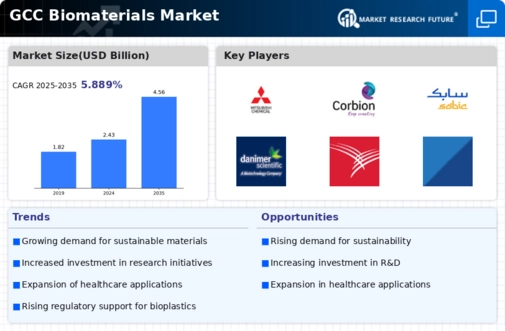Regulatory Framework Enhancements
The regulatory landscape surrounding biomaterials is evolving, with governments in the GCC implementing stricter regulations to promote sustainable practices. These enhancements in the regulatory framework are designed to encourage the adoption of biomaterials across various sectors. For instance, initiatives aimed at reducing plastic waste and promoting biodegradable alternatives are gaining traction. In 2025, it is anticipated that compliance with these regulations will drive a 20% increase in the use of biomaterials in packaging applications alone. This regulatory support not only facilitates market growth but also ensures that the biomaterial market aligns with broader environmental goals.
Growing Applications in Healthcare
The healthcare sector is witnessing a surge in the adoption of biomaterials, significantly impacting the biomaterial market in the GCC. Biomaterials are increasingly utilized in medical devices, tissue engineering, and drug delivery systems. The demand for biocompatible materials is on the rise, driven by advancements in medical technology and an aging population. In 2025, the healthcare segment is projected to account for approximately 30% of the total biomaterial market share. This growth is indicative of the sector's potential, as it continues to explore innovative applications for biomaterials, thereby enhancing patient outcomes and driving market expansion.
Investment in Research and Development
Investment in research and development (R&D) is a crucial driver for the biomaterial market in the GCC. Companies are increasingly allocating resources to explore new biomaterials and improve existing ones. This focus on R&D is essential for developing advanced materials that meet the specific needs of various industries, including healthcare, packaging, and construction. In 2025, it is estimated that R&D expenditures in the biomaterial sector will account for approximately 15% of total market investments. This commitment to innovation not only fosters technological advancements but also positions the biomaterial market as a competitive player in the global arena, attracting further investments and partnerships.
Rising Demand for Eco-Friendly Products
The increasing consumer awareness regarding environmental sustainability is driving the biomaterial market in the GCC. As consumers become more conscious of their ecological footprint, there is a notable shift towards eco-friendly products. This trend is reflected in the growing demand for biodegradable materials, which are perceived as a viable alternative to traditional plastics. In 2025, the biomaterial market is projected to reach a valuation of approximately $1.5 billion in the GCC, with a compound annual growth rate (CAGR) of around 12% over the next five years. This rising demand is prompting manufacturers to innovate and develop new biomaterials that align with consumer preferences, thereby enhancing their market presence.
Collaboration with Academic Institutions
Collaboration between industry players and academic institutions is emerging as a vital driver for the biomaterial market in the GCC. Such partnerships facilitate knowledge transfer and foster innovation in biomaterial development. Universities and research centers are increasingly engaged in projects that explore novel biomaterials and their applications. In 2025, it is expected that collaborative initiatives will contribute to a 10% increase in the introduction of new biomaterials to the market. This synergy between academia and industry not only accelerates the pace of innovation but also enhances the overall competitiveness of the biomaterial market.

















Leave a Comment